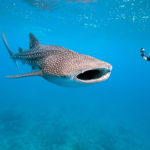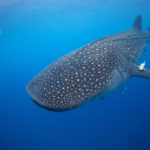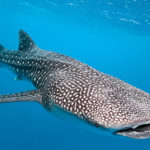Basking sharks
 This species of sharks is the second largest, yielding the palm of superiority to only the whale shark. The average length of a basking shark is 10 meters, and the average weight reaches four tons. There were recorded cases when the length of this fish was 15 meters, but there is no official data confirming the existence of such large specimens. For the sake of justice, it should be noted that less than three meters, these fish do not exist, in any case, all caught specimens exceed this size.
This species of sharks is the second largest, yielding the palm of superiority to only the whale shark. The average length of a basking shark is 10 meters, and the average weight reaches four tons. There were recorded cases when the length of this fish was 15 meters, but there is no official data confirming the existence of such large specimens. For the sake of justice, it should be noted that less than three meters, these fish do not exist, in any case, all caught specimens exceed this size.
Habitat for themselves basking sharks have chosen moderately warm waters of the Pacific and Atlantic oceans. The form of the body is a basking shark like a huge cigar. Skin can be painted in colors from dark gray to black.
Sometimes you can meet individuals of brown color. The abdomen has a lighter color than on the sides and on the back. The muzzle of this shark is considerably advanced, and in the young the snout can even resemble a short trunk. Because of this feature, the first researchers mistakenly thought that these are two different subspecies of a basking shark. Later, this statement was abandoned, discovering that in adults this trunk disappears.
On both sides of the head are gill slits, the sizes of which surpass the analogous organs of all fish known to us. The filtration of water is carried out with the help of horny stamens, which are located on the gill arches from the side of the mouth. And the number of them can be from 1000 to 1300 pieces. The basking shark feeds on plankton only, and this explains the very small size of its teeth, which are simply microscopic compared to the teeth of other sharks. These five-millimeter teeth are located in five to seven rows, and look like a small grater, and not teeth.
A basking shark has a very large liver. Its mass is a quarter of the weight of this huge fish. This organ is a kind of float, allowing this fish to stay in the water without going to the bottom. In front of the body are two large pectoral fins, which also help the body of the shark to stay afloat. The role of the helm is played by a symmetrical caudal fin, and its upper part is considerably larger in size than its lower one.



























